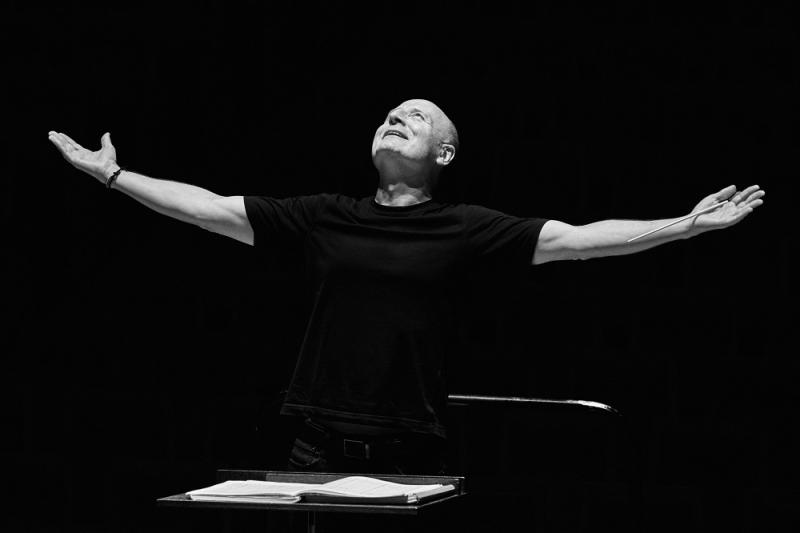Mahler’s Third Symphony, Philharmonia, Paavo Järvi, RFH review - phosphorescent glow, depths only glimpsed | reviews, news & interviews
Mahler’s Third Symphony, Philharmonia, Paavo Järvi, RFH review - phosphorescent glow, depths only glimpsed
Mahler’s Third Symphony, Philharmonia, Paavo Järvi, RFH review - phosphorescent glow, depths only glimpsed
Stylish conducting, classy playing, but no big emotions in the crucial finale

This longest, wackiest and most riskily diverse of Third Symphonies became Esa-Pekka Salonen’s personal property during his years as the Philharmonia's Principal Conductor. His successor, Santtu-Matias Rouvali, has (in)famously said he’s not interested in Mahler. Two of the orchestra’s most distinguished visitors, Jakub Hrůša and Paavo Järvi, certainly are, so after Hrůša’s blazing Second, hopes were high for Järvi’s Third.
It delivered in terms of masterful conducting, effortless in every gear change, and in all those sonorities which must have seemed outrageously novel in 1896; when the playing’s as good as the Philharmonia's, they still have the capacity to surprise. The echo-aftermath of the horns’ big summons at the start was especially startling; Mahler's idiosyncratic take on the May Day marchers who take over from solemn nature sounded brilliant, if kept on the leash (sometimes a touch of apparent out-of-controlness is good). I’d never quite registered the levels of delicate virtuosity required for the second-movement flower picture, so innocuous at the start; the woodland panics of the scherzo could not have been more magically offset by the distant flügelhorn (the programme credited flawless James Fountain as “offstage trumpet”, but whatever the instrument, the sound was exactly right).
 The spell was broken a little by Hogni Wu’s delivery of the Nietzsche text in the midnight song (the mezzo pictured left); several phrases bloomed, but you really need a rock-steady contraltoish tone for the oracular pronouncements, From dark to bright, and the matin bells of the next vocal number had all the cheek Mahler asks for from the excellent Tiffin Boys’ Choir, offset by the classy ladies of the professional Philharmonia Voices.
The spell was broken a little by Hogni Wu’s delivery of the Nietzsche text in the midnight song (the mezzo pictured left); several phrases bloomed, but you really need a rock-steady contraltoish tone for the oracular pronouncements, From dark to bright, and the matin bells of the next vocal number had all the cheek Mahler asks for from the excellent Tiffin Boys’ Choir, offset by the classy ladies of the professional Philharmonia Voices.
Then comes the big test: can the conductor really pull off the finale’s long ascent to the heights? Salonen came to do so over time; the benchmark here will always be Haitink’s absolute naturalness. Perhaps the relationship with the orchestra needs to be a long-term, consistent one to dig deep. This was glowing on the surface, but didn’t move me; there’s a fine line between universal and self love in putting across what Mahler demands here. It’s a tough ask after so much hard work over the previous 75 or so minutes – no surprise if the trumpeters, so good up to the final minutes, sounded less than seraphic in the last haul – and this was no failure. But less, for once, would have been more.
rating
Share this article
The future of Arts Journalism
You can stop theartsdesk.com closing!
We urgently need financing to survive. Our fundraising drive has thus far raised £49,000 but we need to reach £100,000 or we will be forced to close. Please contribute here: https://gofund.me/c3f6033d
And if you can forward this information to anyone who might assist, we’d be grateful.

Subscribe to theartsdesk.com
Thank you for continuing to read our work on theartsdesk.com. For unlimited access to every article in its entirety, including our archive of more than 15,000 pieces, we're asking for £5 per month or £40 per year. We feel it's a very good deal, and hope you do too.
To take a subscription now simply click here.
And if you're looking for that extra gift for a friend or family member, why not treat them to a theartsdesk.com gift subscription?
more Classical music
 theartsdesk at the Lahti Sibelius Festival - early epics by the Finnish master in context
Finnish heroes meet their Austro-German counterparts in breathtaking interpretations
theartsdesk at the Lahti Sibelius Festival - early epics by the Finnish master in context
Finnish heroes meet their Austro-German counterparts in breathtaking interpretations
 Classical CDs: Sleigh rides, pancakes and cigars
Two big boxes, plus new music for brass and a pair of clarinet concertos
Classical CDs: Sleigh rides, pancakes and cigars
Two big boxes, plus new music for brass and a pair of clarinet concertos
 Waley-Cohen, Manchester Camerata, Pether, Whitworth Art Gallery, Manchester review - premiere of no ordinary violin concerto
Images of maternal care inspired by Hepworth and played in a gallery setting
Waley-Cohen, Manchester Camerata, Pether, Whitworth Art Gallery, Manchester review - premiere of no ordinary violin concerto
Images of maternal care inspired by Hepworth and played in a gallery setting
 BBC Proms: Barruk, Norwegian Chamber Orchestra, Kuusisto review - vague incantations, precise laments
First-half mix of Sámi songs and string things falters, but Shostakovich scours the soul
BBC Proms: Barruk, Norwegian Chamber Orchestra, Kuusisto review - vague incantations, precise laments
First-half mix of Sámi songs and string things falters, but Shostakovich scours the soul
 BBC Proms: Alexander’s Feast, Irish Baroque Orchestra, Whelan review - rapturous Handel fills the space
Pure joy, with a touch of introspection, from a great ensemble and three superb soloists
BBC Proms: Alexander’s Feast, Irish Baroque Orchestra, Whelan review - rapturous Handel fills the space
Pure joy, with a touch of introspection, from a great ensemble and three superb soloists
 BBC Proms: Moore, LSO, Bancroft review - the freshness of morning wind and brass
English concert band music...and an outlier
BBC Proms: Moore, LSO, Bancroft review - the freshness of morning wind and brass
English concert band music...and an outlier
 Willis-Sørensen, Ukrainian Freedom Orchestra, Wilson, Cadogan Hall review - romantic resilience
Passion, and polish, from Kyiv's musical warriors
Willis-Sørensen, Ukrainian Freedom Orchestra, Wilson, Cadogan Hall review - romantic resilience
Passion, and polish, from Kyiv's musical warriors
 BBC Proms: Faust, Gewandhausorchester Leipzig, Nelsons review - grace, then grandeur
A great fiddler lightens a dense orchestral palette
BBC Proms: Faust, Gewandhausorchester Leipzig, Nelsons review - grace, then grandeur
A great fiddler lightens a dense orchestral palette
 BBC Proms: Jansen, Royal Concertgebouw Orchestra, Mäkelä review - confirming a phenomenon
Second Prom of a great orchestra and chief conductor in waiting never puts a foot wrong
BBC Proms: Jansen, Royal Concertgebouw Orchestra, Mäkelä review - confirming a phenomenon
Second Prom of a great orchestra and chief conductor in waiting never puts a foot wrong
 BBC Proms: Royal Concertgebouw Orchestra, Mäkelä review - defiantly introverted Mahler 5 gives food for thought
Chief Conductor in Waiting has supple, nuanced chemistry with a great orchestra
BBC Proms: Royal Concertgebouw Orchestra, Mäkelä review - defiantly introverted Mahler 5 gives food for thought
Chief Conductor in Waiting has supple, nuanced chemistry with a great orchestra
 Dunedin Consort, Butt / D’Angelo, Muñoz, Edinburgh International Festival 2025 review - tedious Handel, directionless song recital
Ho-hum 'comic' cantata, and a song recital needing more than a beautiful voice
Dunedin Consort, Butt / D’Angelo, Muñoz, Edinburgh International Festival 2025 review - tedious Handel, directionless song recital
Ho-hum 'comic' cantata, and a song recital needing more than a beautiful voice
 Classical CDs: Dungeons, microtones and psychic distress
This year's big anniversary celebrated with a pair of boxes, plus clarinets, pianos and sacred music
Classical CDs: Dungeons, microtones and psychic distress
This year's big anniversary celebrated with a pair of boxes, plus clarinets, pianos and sacred music

Add comment